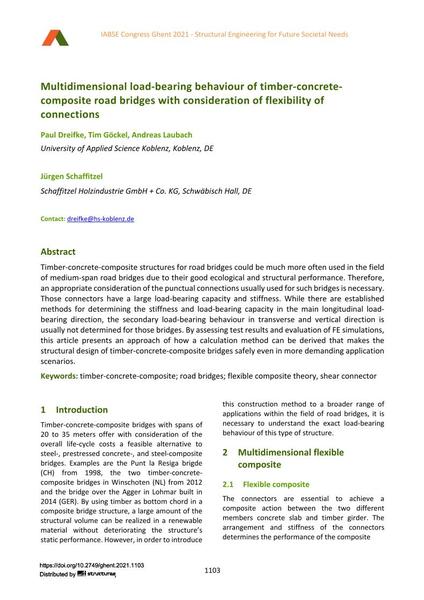Multidimensional load-bearing behaviour of timber-concrete composite road bridges with consideration of flexibility of connections

|
|
|||||||||||
Détails bibliographiques
| Auteur(s): |
Paul Dreifke
(University of Applied Science Koblenz, Koblenz, DE)
Tim Göckel (University of Applied Science Koblenz, Koblenz, DE) Andreas Laubach (University of Applied Science Koblenz, Koblenz, DE) Jürgen Schaffitzel (Schaffitzel Holzindustrie GmbH + Co. KG, Schwäbisch Hall, DE) |
||||
|---|---|---|---|---|---|
| Médium: | papier de conférence | ||||
| Langue(s): | anglais | ||||
| Conférence: | IABSE Congress: Structural Engineering for Future Societal Needs, Ghent, Belgium, 22-24 September 2021 | ||||
| Publié dans: | IABSE Congress Ghent 2021 | ||||
|
|||||
| Page(s): | 1103-1109 | ||||
| Nombre total de pages (du PDF): | 7 | ||||
| DOI: | 10.2749/ghent.2021.1103 | ||||
| Abstrait: |
Timber-concrete-composite structures for road bridges could be much more often used in the field of medium-span road bridges due to their good ecological and structural performance. Therefore, an appropriate consideration of the punctual connections usually used for such bridges is necessary. Those connectors have a large load-bearing capacity and stiffness. While there are established methods for determining the stiffness and load-bearing capacity in the main longitudinal load- bearing direction, the secondary load-bearing behaviour in transverse and vertical direction is usually not determined for those bridges. By assessing test results and evaluation of FE simulations, this article presents an approach of how a calculation method can be derived that makes the structural design of timber-concrete-composite bridges safely even in more demanding application scenarios. |
||||
| Mots-clé: |
ponts-routes
|
||||
| Copyright: | © 2021 International Association for Bridge and Structural Engineering (IABSE) | ||||
| License: | Cette oeuvre ne peut être utilisée sans la permission de l'auteur ou détenteur des droits. |
||||
